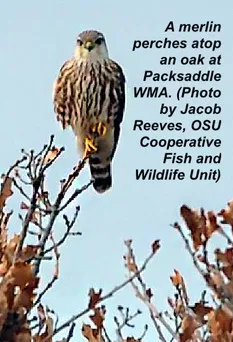
SPECIAL WEATHER STATEMENT
Biologists with the Oklahoma Department of Wildlife Conservation are closely monitoring the effects of record cold weather and heavy snowfall that arrived in the state over the weekend and is forecast to continue for several days. The Wildlife Department values your reports from the field. Please share observations about the weather's impacts on quail populations and habitat via email to tell.judkins@odwc.ok.gov.
More about catastrophic weather events and quail mortality can be found in these ODWC publications:
- https://www.wildlifedepartment.com/sites/default/files/upland_urgengcy.pdf
- https://www.wildlifedepartment.com/sites/default/files/2020_QuailHabitatGuide.pdf
Quail Ecology and Management Project Report for January 2021
Provided by Oklahoma Cooperative Fish and Wildlife Research Unit, Oklahoma State University
No new transmitters were deployed in January, as trapping efforts were concluded in mid-December. However, two transmitters were recovered from Packsaddle Wildlife Management Area in January. Both birds were determined to have succumbed in late December, with one showing signs of mammalian predation, and the other with no clear signs of the cause of death.
During January, three GPS transmitters remained active, all of them at Beaver River Wildlife Management Area. Those three transmitters were of the type with satellite-download.
In total, 64,954 individual locations have been collected from transmitters since the launch of the first transmitter in May 2018. Analyses of bird survey data and vegetation data, as well as movement data from the GPS transmitters continued during January.
INVERTEBRATE STUDY: Jacob Reeves spent most of the month at Packsaddle WMA collecting seeds to observe if fire influenced food availability across the landscape. He also conducted raptor surveys to see if time-since-fire and seed availability are related to avian predation pressure across the study area.
In addition, Reeves conducted covey call surveys in the first part of the month but stopped after not hearing any covey calls in the northern half of the study area. He collected seeds in areas of current-year burns, one-year post burn, and areas burned greater than one year prior. The study area was divided into north and south blocks to account for topographical changes at Packsaddle. Each block had one of each type of burn treatment.
Anecdotally, it appeared that the one-year post-burn sites had the largest amount of vegetation variation and appropriate cover for bobwhites. It also appeared as if the north block of sites had more productive vegetation than the south block. Processing of collected seed samples will be needed to better understand spatial variation in food availability.

Raptor surveys were dominated by only a few species, especially northern harriers (see top photo). The other most prominent raptor species Reeves observed was the American kestrel, which typically feeds on invertebrates, small mammals, and songbirds but have been known to occasionally take larger prey. Red-tailed hawks were also observed in the study area, but only two or three times.
A more elusive winter visitor observed was the merlin. Merlins, which mainly hunt smaller birds but have been known to occasionally capture larger birds, appeared in the study area during the last 10 days of January. One merlin was observed following and harassing a northern harrier until the harrier left the merlin’s hunting area.
* * *
(This project is funded in part by the Oklahoma Department of Wildlife Conservation, Federal Aid Project F18AF001-10: Quail Ecology and Management II.)